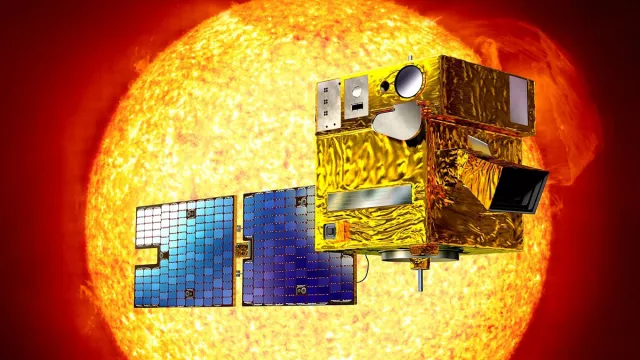From 2010 to 2014, the Picard satellite acquired more than a million pictures of the Sun, along with many other measurements. Scientists are still sifting through the data to learn more about how our star works and better understand what drives its variations.
Key information
| Mission | Study the Sun |
|---|---|
| Domain | Science |
| Launch date | 15 June 2010 |
| Partners | CNRS, LATMOS, Swiss Space Office, Belgian Federal Science Policy Office, PMOD laboratory at Davos Observatory and the Belgian Royal Meteorological Institute (IRMB) |
| Where | Sun-synchronous orbit 725 km from the Sun, thus ensuring an almost uninterrupted view |
| Lifetime | Mission ended 4 April 2014 |
| Status | Completed |
Key figures
- 150 kg: satellite mass
- 1 million+ pictures of the Sun taken by satellite
- 3 instruments
- 90 cm x 80 cm x 110 cm: satellite dimensions
Key milestones
- 4 April 2014: End of mission
- 15 June 2010: Launch of Picard by Dnepr
- June 2007: Satellite integration begins
- December 2004: CNES gives go-ahead for project
- February 2000: Project kick-off
Project in brief
What is the Sun’s diameter? In the 17th century, French astronomer Jean Picard was the first to make rigorous measurements. A few centuries later, from 2010 to 2014, the Picard microsatellite acquired extremely precise data to measure the Sun’s rate of rotation, the flattening of its poles and radiated power (total and spectral irradiance), while also probing its interior (helioseismology).
Research scientists are today still sifting through this treasure trove of data to learn more about our Sun’s inner workings and its impact on Earth’s climate.
CNES’s role
CNES initiated the Picard mission and was responsible for developing the satellite’s Myriade bus and for in-orbit operations.
Contacts
Sun, Heliosphere & Magnetospheres (SHM) subject matter expert
Kader Amsif
E-mail: kader.amsif at cnes.fr


